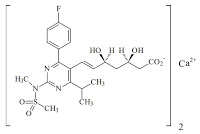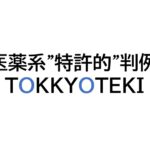クレストールANDA訴訟CAFC判決、アストラゼネカ・塩野義が勝訴: CAFC Docket No.2010-1460
【背景】
The drug product here at issue is the “statin” having the brand name Crestor®. The active ingredient of Crestor® is rosuvastatin. In suit is United States Reissue Patent No. 37,314 (“the ’314 patent”), which is a reissue of United States Patent No.5,260,440 (“the ’440 patent”). The patentee is “Shionogi” and the exclusive licensee is “Astrazeneca” (collectively “Plaintiffs”). Several generic producers (Defendants) initiated a challenge to the ’314 patent by filing an Abbreviated New Drug Application (ANDA) accompanied by a Paragraph IV certification. The Defendants argued that the ’314 patent is invalid on the ground of obviousness and improper reissue, and that the patent is unenforceable for inequitable conduct in the USPTO. The district court ruled that the ’314 patent is valid, enforceable, and infringed. All of the Defendants appeal the rulings of validity and enforceability.
【要旨】
I VALIDITY
The district court concluded that the Defendants did not demonstrate the required motivation for selecting Sandoz Compound 1b as a lead compound, or for making this specific sulfonyl change in the Compound 1b molecule. See Eli Lilly & Co. v. Zenith Goldline Pharms.,471 F.3d 1369, 1379 (Fed. Cir. 2006) (considering whether a prior art compound would have been chosen as a lead compound). We agree that “obvious to try” was negated by the general skepticism concerning pyrimidine-based statins, the fact that other pharmaceutical companies had abandoned this general structure, and the evidence that the prior art taught a preference not for hydrophilic substituents but for lipophilic substituents at the C2 position. See Takeda Chem.
Indus., Ltd. v. Alphapharm Pty., 492 F.3d 1350, 1357 (Fed.Cir. 2007) (“[I]n cases involving new chemical compounds, it remains necessary to identify some reason that would have led a chemist to modify a known compound in a particular manner to establish prima facie obviousness of a new claimed compound.”). The district court correctly held that patent invalidity on the ground of obviousness had not been shown for the compound rosuvastatin. That ruling is affirmed.
II INEQUITABLE CONDUCT
1. Materiality
Although the references were held by the PTO not to negate patentability of rosuvastatin, as affirmed ante, we do not disturb the district court’s finding of materiality.
2. Intent
The district court found that the Defendants did not establish that either Ms. Kitamura or Mr. Shibata withheld the Sandoz and Bayer references with deceptive intent. Although deceptive intent may be inferred from circumstantial evidence, the inference “must not only be based on sufficient evidence and be reasonable in light of that evidence, but it must also be the single most reasonable inference able to be drawn from the evidence to meet the clear and convincing standard.” Star Scientific, 537 F.3d at 1366; see also Therasense, 649 F.3d at 1290. We agree that clear and convincing evidence did not show that Ms. Kitamura and Mr. Shibata made a deliberate decision to withhold references from the PTO. The court in Therasense sought to impart objectivity to the law of inequitable conduct by requiring that “the accused infringer must prove that the patentee acted with the specific intent to deceive the PTO,” 649 F.3d at 1290. Recognizing the complexity of patent prosecution, negligence—even gross negligence—is insufficient to establish deceptive intent. We affirm that unenforceability based on inequitable conduct was not established.
III REISSUE
The Defendants also argued that the ’314 patent was improperly reissued, arguing that the statutory reissue requirement of error without deceptive intent had not been met. The Defendants argued that (1) there was no error, and (2) there was deceptive intent. In view of the circumstances necessitating the reissue procedure in order to bring the uncited references before the examiner, it is not clear how the limitation of the claims to the compound of commercial interest suggests that the prior flawed procedures were based on deceptive intent. In sum, the district court correctly found that reissue was available, and that the scope of the reissue was in accordance with law.
IV INFRINGEMENT
The judgment of infringement against all of the Defendants is affirmed.
AFFIRMED
【コメント】
Deceptive intentがあったのかなかったのかの判断がどっちに転んでもおかしくないくらいの非常にスレスレの事案だったかもしれない。Mayer判事は、不適法なreissueのためにreissue特許は無効であり従って侵害はないとの反対意見を述べている。
参考:
- AstraZeneca press release: 2012.12.14 CRESTOR US patent upheld by Court of Appeals for the Federal Circuit
- シオノギ press release: 2012.12.17 米国における「クレストール®」特許侵害訴訟の控訴審判決での勝訴について
- 2010.06.29 「クレストールANDA訴訟地裁判決、アストラゼネカ・塩野義が勝訴」



コメント